NEW YORK (CNNfn) - It wasn't long ago that the best-performing mutual funds packed a serious tax wallop. They had soared so much in value that the potential capital gains exposure was huge.
The problem wasn't so bad for long-term investors, who benefited from the stellar returns. But new investors, lured by the performance charts, risked a big tax bill with no payoff in their portfolios.
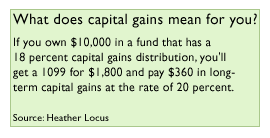 Now, because of a falling market, a lot of large growth funds and tech funds have a clean slate when it comes to capital gains. And financial advisers say it's a good time to get in, even though the funds are losing money. Now, because of a falling market, a lot of large growth funds and tech funds have a clean slate when it comes to capital gains. And financial advisers say it's a good time to get in, even though the funds are losing money.
"Those built-in gains have all been wiped out," said Heather Locus, a certified financial planner from Schaumburg, Ill. "It was amazing when I looked at funds and saw how much the capital gains had changed."
IRS rules require investors to pay 20 percent on gains on assets held more than one year. Short-term gains on assets held less than a year are taxed at income tax rates of up to 39.6 percent.
Last year, a lot of fund investors had the double-whammy of capital gains bills as well as big market losses. Managers had to sell stocks in order to meet massive redemptions.
The silver lining in a falling market?
Chicago fund-tracker Morningstar calculates potential capital gains exposure by using net unrealized gains or losses, which are figures from a fund company's annual report, said analyst Russ Kinnel.
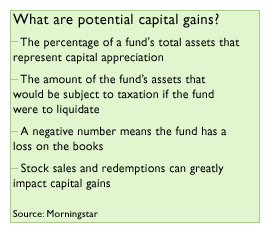 If a fund bought Wal-Mart (WMT: Research, Estimates) at $10 a share and it's now selling for $50 a share, it has an unrealized appreciation of $40, Kinnel said. If the manager sells, there's a capital gains of $40. If a fund bought Wal-Mart (WMT: Research, Estimates) at $10 a share and it's now selling for $50 a share, it has an unrealized appreciation of $40, Kinnel said. If the manager sells, there's a capital gains of $40.
A potential capital gains exposure of, say, 67 percent means that the overall portfolio has an average gain of 67 percent from when the manager bought the shares.
Kinnel in a recent analysis found 58 domestic stock funds with a potential capital gains exposure of less than 0, based on the most recently available figures. That means the average stock in the fund is being held at a loss, he said.
"There are thousands of funds with no capital gains exposure," Kinnel said.
Check your mutual funds on CNNmoney.com.
What a difference a year makes.
In 2000, investors getting into high-flying funds had a "perfect recipe for paying someone else's tax bill," Kinnel said. Funds that were soaring in late 1999 might not have sold any holdings going into 2000. Unlucky investors bought shares before the market peaked in March 2000. Then U.S. stocks went south and most funds ended the year with big losses.
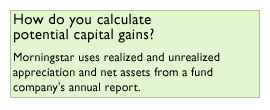
The red ink has continued in 2001, with earnings warnings and fears about a slowing economy putting a chill on Wall Street.
"This is a fairly attractive time to invest," Kinnel said.
Some funds with a clean slate
For example, Locus found that the potential capital gains exposure for Fidelity OTC dropped to minus-10 percent of assets as of Feb. 28 from 57 percent of assets a year ago. That means the fund has a 10 percent loss on the books to offset future gains.
Last year, the Fidelity fund lost 26.81 percent and had a capital gains distribution of 30 percent. On a $10,000 investment you'd get a 1099 IRS form for $3,000. You'd pay $600, or 20 percent, for long-term capital gains.
Likewise, Janus Fund's potential capital gains exposure dropped to 3 percent of assets as of Feb. 28 from 38 percent of assets a year ago, Locus said. The Janus fund lost 14.9 percent in 2000 and had a capital gains distribution in 2000 of 13 percent.
CNNfn.com special report: Tax Time!
And Putnam New Opportunities Fund saw its potential capital gains exposure drop to minus-4 percent of assets as of Feb. 28 from 67 percent a year ago, Locus said. In 2000, the fund lost 26.15 percent and had a capital gains distribution of 16 percent.
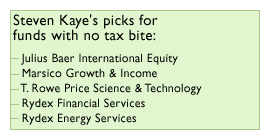 The numbers are dropping even from the end of 2000, financial pros say. The numbers are dropping even from the end of 2000, financial pros say.
Steven Kaye, a certified financial planner from Watchung, N.J., found that a solid fund like T. Rowe Price Science & Technology now has a potential capital gains exposure of minus-50 percent as of Feb. 28, compared to minus-21 percent as of Dec. 31, 2000. Julius Baer International Equity's potential capital gains exposure is at minus-6 percent, compared to 26 percent at the end of last year.
Another top fund, Marsico Growth & Income, headed by star manager Tom Marsico, has seen its potential capital gains exposure drop to 10 percent as of Feb. 28 from 21 percent as of December 2000. 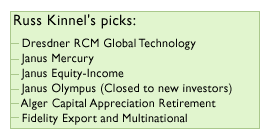
Locus said a common theme among funds with less capital gains bite is that they invest in large growth or technology stocks.
"The tax potential is much better now," Locus said.
Still, Kaye pointed out that it's hard to find a fund that is doing well and limiting the tax punch at the same time.
One exception might be Turner Micro Cap Growth, which earned 19 percent in 2000 and is up 0.47 percent this year, Kaye said. The potential capital gains has stayed the same - about 19 percent - meaning the fund is growing and the tax bite isn't.
"If a fund does well its tax potential will go up," Kaye said. "Saying the tax potential is down is the same thing as saying the fund is down. You're going to go into a fund that has lost money in the last couple of years in most cases." 
|

